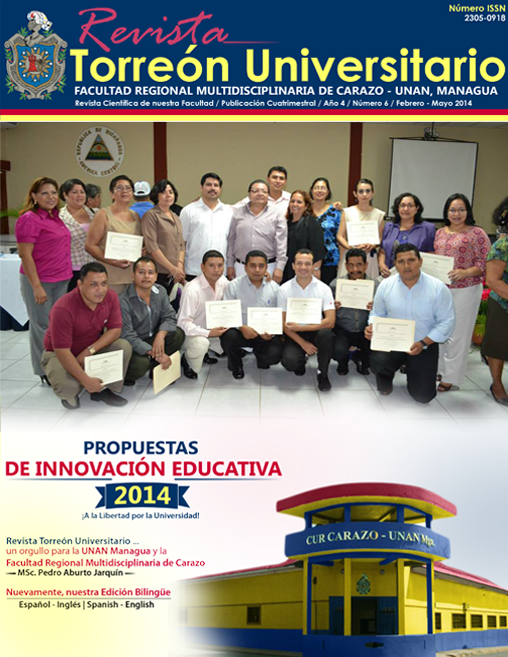Teacher training in TAC "English laboratory", educational innovation proposal
Keywords:
Communication Technologies for Learning (TAC), Meaningful Learning, Teaching - learning processAbstract
This paper presents the results of an institutional teaching experience made in the Regional Multidisciplinary Faculty Carazo of the UNAN - Managua on technology training of teachers in the area for the application of English Communication Technologies for Learning (TAC) in the process of teaching -and thus how to search for meaningful learning to equip the students in your are appropriate to deal with this new digital knowledge society technological skills.
Downloads
References
Chamorro, M., & Sánchez, P. (2005). Iniciación a la docencia universitaria. Manual de ayuda. Universidad Complutense de Madrid, Instituto de Ciencias de la Educación.
Duart, J. (2005). Integrar las TAC en la universidad. RU & SC .
Guzmán, T., García, M., & Chaparro, R. (s.f.). UDGVIRTUAL. Recuperado el 23 de marzo de 2013, de http://www.udgvirtual.udg.mx/apertura/index.php/apertura3/arTACle/view/181/196
Llorente, M., Marín, V., & Cabero, J. (2010). Hacia el diseño de un instrumento de diagnósTACo de "competencias tecnológicas del profesorado" universitario. Revista Iberoamericana de Educación , 1-12.
MANAGUA, U. (2011). Modelo educativo, normativa y metodología para la planificación currícular 2011. Managua.
Mejía, N. (s.f.). Grupos de investigación (UdeA). Recuperado el 28 de marzo de 2013, de http://aprendeenlinea.udea.edu.co/lms/investigacion/course/view.php?id=60
Pérez, B., & Salas, F. (2009). Hallazgos en investigación sobre el profesorado universitario y la integración de las TAC en la enseñanza. Actualidades Investigativas en Educación (UCR) , 1-25.
Tapia, C., Gutiérrez, H., Cruz, E., & Fletes, O. (2011). Proyecto TAC, FAREM-Carazo. Jinotepe.
UNESCO. (s.f.). Estándares docentes UNESCO. Recuperado el 12 de mayo de 2013, de http://www.eduteka.org/pdfdir/UNESCOEstandaresDocentes.pdf
Downloads
Published
Issue
Section
License
Copyright (c) 2014 National Autonomous University of Nicaragua, Managua

This work is licensed under a Creative Commons Attribution-NonCommercial-NoDerivatives 4.0 International License.
The authors who publish in this journal agree to the following terms.
- The author or authors of the articles, essays or research grant the National Autonomous University of Nicaragua, Managua (UNAN-Managua) the editing rights (copyright) of the submitted work, therefore the University has the exclusive right to publish the article for the entire copyright period.
- These copyrights/authors authorize Torreón Universitario Magazine and the University to edit and disseminate/publish the article in said Magazine, including printed and electronic reproduction, storage, retrieval and any other type of publication, and sources of secondary information as services. of summaries and databases, they also empower it to protect the article against unauthorized use for dissemination by printed or electronic media (PDF, HTML, EPUB, XML or others).
License for use of content
The magazine uses the Creative Commons Attribution-NonCommercial-NoDerivs 4.0 International License.
Under this statement:

This journal is licensed under a Creative Commons Attribution-NonCommercial-NoDerivatives 4.0 International License. It can be copied, distributed and transmitted publicly as long as the author and source are cited (Revista Torreón Universitario), it should not be modified or used for any commercial purpose. The full license can be found at http://creativecommons.org/licenses/by-nc-nd/4.0/.



